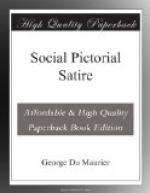John Leech! What a name that was to conjure with, and is still!
I cannot find words to express what it represented to me of pure unmixed delight in my youth and boyhood, long before I ever dreamed of being an artist myself! It stands out of the path with such names as Dickens, Dumas, Byron—not indeed that I am claiming for him an equal rank with those immortals, who wielded a weapon so much more potent than a mere caricaturist’s pencil! But if an artist’s fame is to be measured by the mere quantity and quality of the pleasure he has given, what pinnacle is too high for John Leech!
Other men have drawn better; deeper, grander, nobler, more poetical themes have employed more accomplished pencils, even in black and white; but for making one glad, I can think of no one to beat him.
To be an apparently hopeless invalid at Christmas-time in some dreary, deserted, dismal little Flemish town, and to receive Punch’s Almanac (for 1858, let us say) from some good-natured friend in England—that is a thing not to be forgotten! I little dreamed then that I should come to London again, and meet John Leech and become his friend; that I should be, alas! the last man to shake hands with him before his death (as I believe I was), and find myself among the officially invited mourners by his grave; and, finally, that I should inherit, and fill for so many years (however indifferently), that half-page in Punch opposite the political cartoon, and which I had loved so well when he was the artist!
Well, I recovered from a long and distressing ailment of my sight which had been pronounced incurable, and came to England, where I was introduced to Charles Keene, with whom I quickly became intimate, and it was he who presented me to Leech one night at one of Mr. Arthur Lewis’s smoking concerts, in the winter of 1860. I remember feeling somewhat nervous lest he should take me for a foreigner on account of my name, and rather unnecessarily went out of my way to assure him that I was rather more English than John Bull himself. It didn’t matter in the least; I have no doubt he saw through it all: he was kindness and courtesy itself; and I experienced to the full that emotion so delightful to a young hero-worshipper in meeting face to face a world-wide celebrity whom he has long worshipped at a distance. In the words of Lord Tennyson:
“I
was rapt
By all the sweet
and sudden passion of youth
Towards greatness
in its elder....”
But it so happened at just this particular period of his artistic career and of mine that he no longer shone as a solitary star of the first magnitude in my little firmament of pictorial social satire. A new impulse had been given to the art of drawing on wood, a new school had been founded, and new methods—to draw straight from nature instead of trusting to memory and imagination—had been the artistic order




